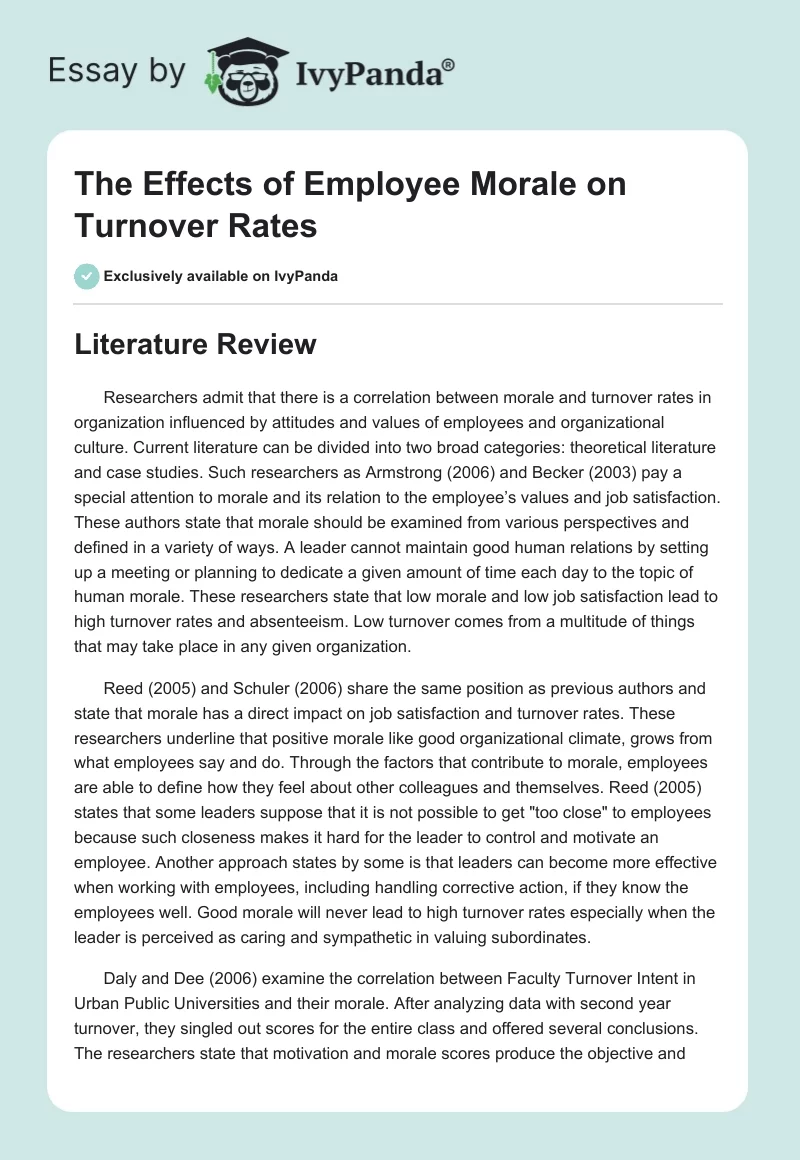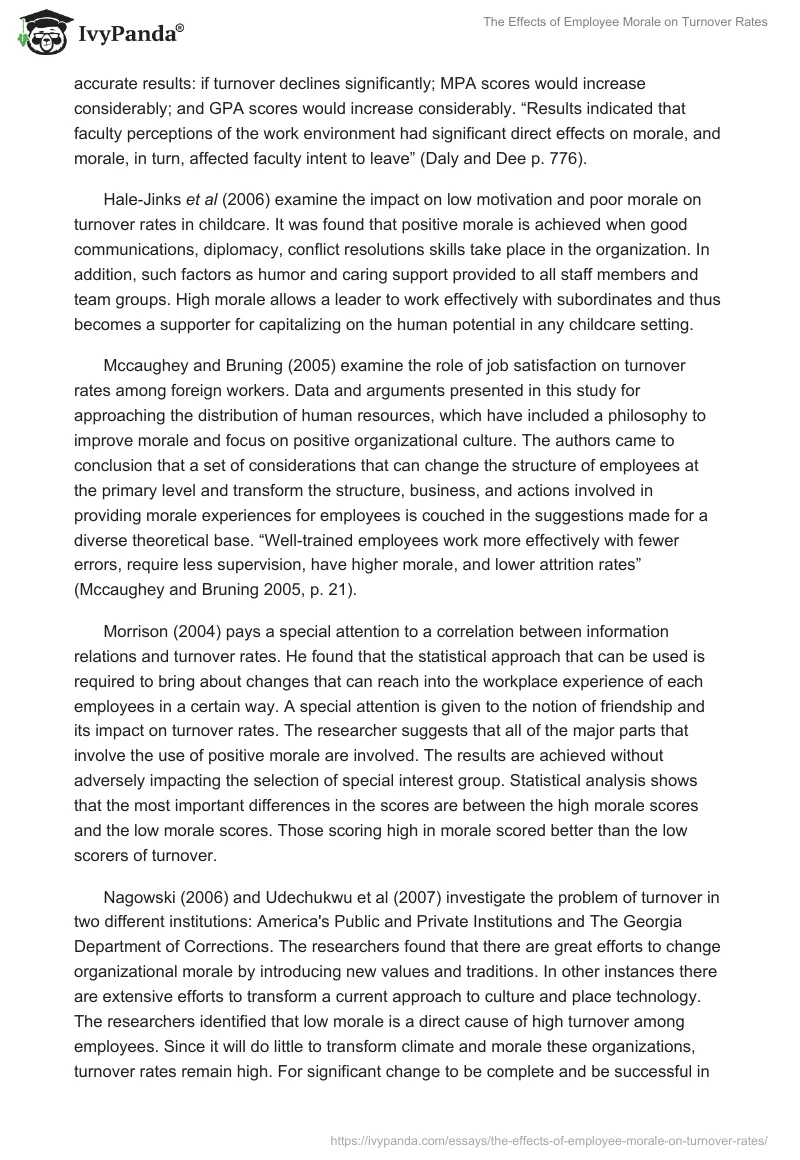Literature Review
Researchers admit that there is a correlation between morale and turnover rates in organization influenced by attitudes and values of employees and organizational culture. Current literature can be divided into two broad categories: theoretical literature and case studies. Such researchers as Armstrong (2006) and Becker (2003) pay a special attention to morale and its relation to the employee’s values and job satisfaction. These authors state that morale should be examined from various perspectives and defined in a variety of ways. A leader cannot maintain good human relations by setting up a meeting or planning to dedicate a given amount of time each day to the topic of human morale. These researchers state that low morale and low job satisfaction lead to high turnover rates and absenteeism. Low turnover comes from a multitude of things that may take place in any given organization.
Reed (2005) and Schuler (2006) share the same position as previous authors and state that morale has a direct impact on job satisfaction and turnover rates. These researchers underline that positive morale like good organizational climate, grows from what employees say and do. Through the factors that contribute to morale, employees are able to define how they feel about other colleagues and themselves. Reed (2005) states that some leaders suppose that it is not possible to get “too close” to employees because such closeness makes it hard for the leader to control and motivate an employee. Another approach states by some is that leaders can become more effective when working with employees, including handling corrective action, if they know the employees well. Good morale will never lead to high turnover rates especially when the leader is perceived as caring and sympathetic in valuing subordinates.
Daly and Dee (2006) examine the correlation between Faculty Turnover Intent in Urban Public Universities and their morale. After analyzing data with second year turnover, they singled out scores for the entire class and offered several conclusions. The researchers state that motivation and morale scores produce the objective and accurate results: if turnover declines significantly; MPA scores would increase considerably; and GPA scores would increase considerably. “Results indicated that faculty perceptions of the work environment had significant direct effects on morale, and morale, in turn, affected faculty intent to leave” (Daly and Dee p. 776).
Hale-Jinks et al (2006) examine the impact on low motivation and poor morale on turnover rates in childcare. It was found that positive morale is achieved when good communications, diplomacy, conflict resolutions skills take place in the organization. In addition, such factors as humor and caring support provided to all staff members and team groups. High morale allows a leader to work effectively with subordinates and thus becomes a supporter for capitalizing on the human potential in any childcare setting.
Mccaughey and Bruning (2005) examine the role of job satisfaction on turnover rates among foreign workers. Data and arguments presented in this study for approaching the distribution of human resources, which have included a philosophy to improve morale and focus on positive organizational culture. The authors came to conclusion that a set of considerations that can change the structure of employees at the primary level and transform the structure, business, and actions involved in providing morale experiences for employees is couched in the suggestions made for a diverse theoretical base. “Well-trained employees work more effectively with fewer errors, require less supervision, have higher morale, and lower attrition rates” (Mccaughey and Bruning 2005, p. 21).
Morrison (2004) pays a special attention to a correlation between information relations and turnover rates. He found that the statistical approach that can be used is required to bring about changes that can reach into the workplace experience of each employees in a certain way. A special attention is given to the notion of friendship and its impact on turnover rates. The researcher suggests that all of the major parts that involve the use of positive morale are involved. The results are achieved without adversely impacting the selection of special interest group. Statistical analysis shows that the most important differences in the scores are between the high morale scores and the low morale scores. Those scoring high in morale scored better than the low scorers of turnover.
Nagowski (2006) and Udechukwu et al (2007) investigate the problem of turnover in two different institutions: America’s Public and Private Institutions and The Georgia Department of Corrections. The researchers found that there are great efforts to change organizational morale by introducing new values and traditions. In other instances there are extensive efforts to transform a current approach to culture and place technology. The researchers identified that low morale is a direct cause of high turnover among employees. Since it will do little to transform climate and morale these organizations, turnover rates remain high. For significant change to be complete and be successful in these organizations, the leaders should recognize that the institution exists in a context that cannot be unnoticed. Turnover can and should be reduce by new cultural values and traditions introduced in these organizations.
References
Armstrong, M. (2006). Human Resource Management. 8th edn. Kogan Page.
Becker, G. (2003). Human capital. New York Columbia University Press, 3rd edn.
Daly, Ch., Dee, J.R. (2006). Greener Pastures: Faculty Turnover Intent in Urban Public Universities. Journal of Higher Education, 77 (5), 776.
Hale-Jinks, C., Knopf, H., Kemple, K. (2006). Tackling Teacher Turnover in Child Care: Understanding Causes and Consequences, Identifying Solutions. Childhood Education, 82 (4), 219.
Mccaughey, D., Bruning, N.S. (2005). Enhancing Opportunities for Expatriate Job Satisfaction: HR Strategies for Foreign Assignment Success. Human Resource Planning, 28 (4), 21.
Morrison, R. (2004). Informal Relationships in the Workplace: Associations with Job Satisfaction, Organisational Commitment and Turnover Intentions. New Zealand Journal of Psychology, 33 (3), 114.
Nagowski, M. P. (2006). Associate Professor Turnover at America’s Public and Private Institutions of Higher Education. American Economist, 50 (1), 69.
Reed, A. (2005). Innovation in Human Resource Management. Chartered Institute of Personnel and Development.
Schuler, R. (2006). Managing Human Resources. Cincinnati, Ohio: South-Western College Publishing,
Udechukwu, I., et al (2007). The Georgia Department of Corrections: An Exploratory Reflection on Correctional Officer Turnover and Its Correlates. Public.


